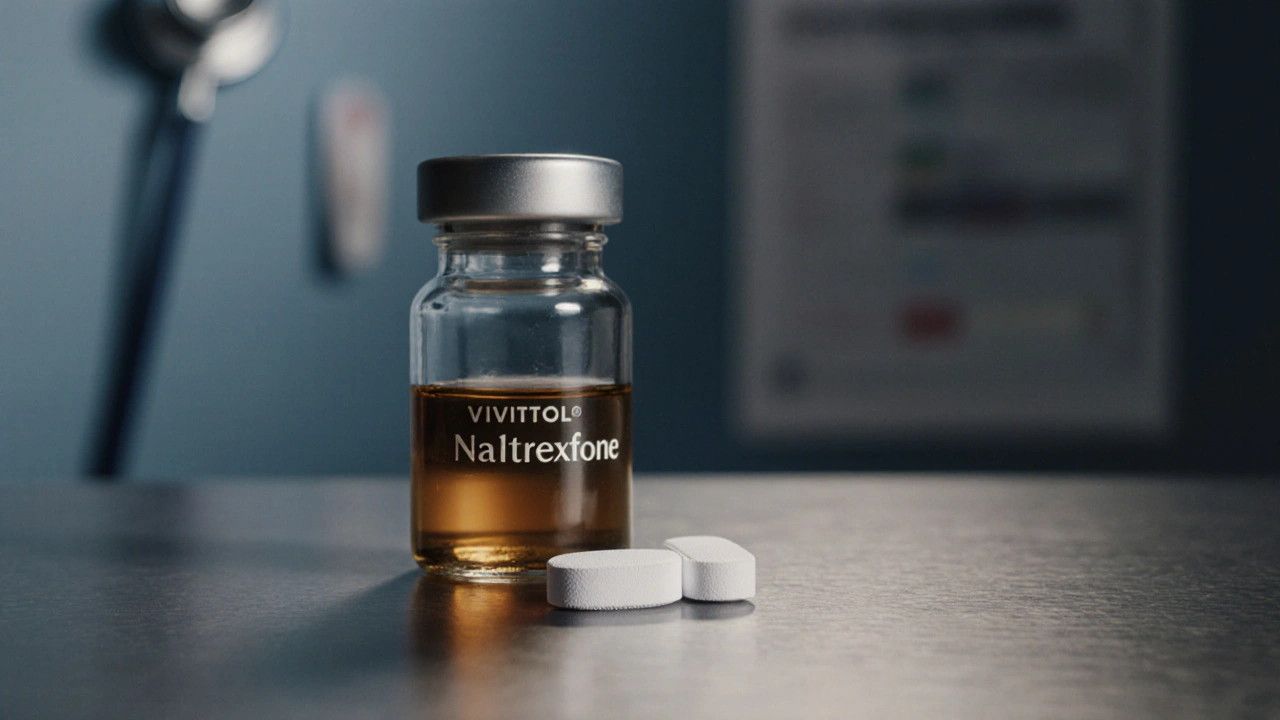Naltrexone vs. Alternatives: Comprehensive Medication Comparison

Naltrexone vs. Alternatives Comparison Tool
Naltrexone
Blocks opioid receptors and reduces alcohol cravings. Available as oral tablets or monthly injections (Vivitrol).
- Primary Uses: OUD & AUD
- Dose: 50mg daily (oral) or 380mg monthly (injectable)
- Side Effects: Nausea, headache, fatigue
Alternatives
Other medications for treating substance use disorders including Acamprosate, Disulfiram, Buprenorphine, and Methadone.
- Acamprosate: Stabilizes brain chemistry for AUD
- Disulfiram: Creates aversive reaction to alcohol
- Buprenorphine: Partial opioid agonist for OUD
- Methadone: Full opioid agonist for severe OUD
| Medication | Primary Use | Typical Dose & Route | Onset of Action | Duration of Effect | Common Side Effects |
|---|---|---|---|---|---|
| Naltrexone (oral) | OUD & AUD | 50 mg once daily - PO | 1-2 hours | 24 hours | Nausea, headache, fatigue |
| Vivitrol (extended-release) | OUD & AUD | 380 mg IM every 28 days | 3-5 days (after injection) | ≈28 days | Injection site pain, insomnia |
| Acamprosate | AUD | 666 mg three times daily - PO | 24-48 hours | Continuous with dosing | Diarrhea, anxiety, metallic taste |
| Disulfiram | AUD | 250 mg once daily - PO | Immediate (upon alcohol intake) | Depends on alcohol exposure | Flushing, vomiting, headache |
| Buprenorphine | OUD | 2-24 mg sublingual daily | 30-60 minutes | 24-72 hours (dose-dependent) | Constipation, mild sedation, withdrawal if stopped abruptly |
| Methadone | OUD | 20-100 mg oral daily (clinic-observed) | 30-60 minutes | 24 hours | QT prolongation, constipation, sweating |
Primary Disorder
If both OUD and AUD, naltrexone offers a single solution. For pure alcohol issues, acamprosate or disulfiram may be simpler.
Structure Required
Daily pills require discipline. Monthly injections or clinic-based methadone reduce daily decision-making but demand appointments.
Side Effects Tolerance
Naltrexone’s liver-related alerts matter if you have hepatitis. Disulfiram’s aversive reaction is a deal-breaker for non-abstinent users.
Safety Considerations
All medications carry contraindications. Always consult a healthcare provider for liver function tests, kidney health, and concurrent medications.
When you’re looking at medication options for opioid or alcohol dependence, the list can feel endless. Naltrexone often shows up as a go‑to choice, but is it truly the best fit for your situation? This article pits Naltrexone against the most common alternatives, breaks down how each works, and helps you decide which drug aligns with your health goals, lifestyle, and safety needs.
Key Takeaways
- Naltrexone blocks opioid receptors and reduces alcohol cravings, making it useful for both Opioid Use Disorder (OUD) and Alcohol Use Disorder (AUD).
- Acamprosate stabilizes brain chemistry after abstinence, primarily for AUD.
- Disulfiram creates an aversive reaction to alcohol, also targeting AUD.
- Buprenorphine (often combined with naloxone) is a partial opioid agonist, best for OUD maintenance.
- Methadone is a full opioid agonist, suited for severe OUD but requires strict clinic monitoring.
What Is Naltrexone?
Naltrexone is an oral or injectable medication that blocks the mu‑opioid receptor, preventing opioids from producing euphoria and reducing the desire to drink alcohol. It comes in two primary forms: a daily 50mg tablet and a once‑monthly extended‑release injection (brand name Vivitrol). FDA‑approved for both OUD and AUD, Naltrexone works by dampening the brain’s reward pathway.
How Naltrexone Works
By occupying the opioid receptors, Naltrexone produces a “chemical blockade.” If an opioid is taken while the drug is present, the user feels little to no high. For alcohol, Naltrexone interferes with the release of dopamine during drinking, which lessens the pleasurable sensations and helps curb cravings.

When to Use Naltrexone
Ideal candidates are people who have already completed detox and can remain opioid‑free for at least 7‑10days before starting the oral version. For alcohol, it works best in individuals motivated to reduce drinking and who can tolerate the medication’s side‑effects. The extended‑release injection is handy for those who struggle with daily pill adherence.
Alternative Medications
Below are the most frequently prescribed alternatives, each with a brief definition and key attributes.
Acamprosate
Acamprosate is an oral medication that helps restore the balance between excitatory and inhibitory neurotransmission after alcohol cessation, reducing cravings. Usually taken as 666mg tablets three times daily, it’s only indicated for AUD and works best when combined with psychosocial support.
Disulfiram
Disulfiram is a deterrent drug that causes unpleasant reactions-flushing, nausea, palpitations-when alcohol is consumed. The standard dose is 250mg daily and it’s strictly for AUD. Success hinges on strict adherence and patient commitment.
Buprenorphine (often as Suboxone)
Buprenorphine is a partial opioid agonist that eases withdrawal and cravings while producing a ceiling effect that limits overdose risk. When combined with naloxone (brand name Suboxone), it discourages injection misuse. Doses range from 2mg to 24mg daily, administered sublingually.
Methadone
Methadone is a full‑strength opioid agonist used in highly structured clinic programs to stabilize severe OUD patients. Doses start around 20‑30mg and can rise to 100mg or more, taken once daily under supervision.
Extended‑Release Naltrexone (Vivitrol)
Vivitrol is the injectable, once‑monthly form of naltrexone that provides steady receptor blockade without daily pills. Each 380mg dose is given by a healthcare professional and lasts about 28days.
Opioid Use Disorder (OUD)
Opioid Use Disorder is a medical condition characterized by compulsive opioid use despite harmful consequences. Treatment may involve medication‑assisted therapy (MAT) such as naltrexone, buprenorphine, or methadone, combined with counseling.
Alcohol Use Disorder (AUD)
Alcohol Use Disorder is a chronic pattern of excessive drinking that leads to health, social, or occupational impairment. Pharmacologic options include naltrexone, acamprosate, and disulfiram, each targeting cravings or deterrence in different ways.
Side‑by‑Side Comparison
| Medication | Primary Use | Typical Dose & Route | Onset of Action | Duration of Effect | Common Side Effects |
|---|---|---|---|---|---|
| Naltrexone (oral) | OUD & AUD | 50mg once daily - PO | 1‑2hours | 24hours | Nausea, headache, fatigue |
| Vivitrol (extended‑release) | OUD & AUD | 380mg IM every 28days | 3‑5days (after injection) | ≈28days | Injection site pain, insomnia |
| Acamprosate | AUD | 666mg three times daily - PO | 24‑48hours | Continuous with dosing | Diarrhea, anxiety, metallic taste |
| Disulfiram | AUD | 250mg once daily - PO | Immediate (upon alcohol intake) | Depends on alcohol exposure | Flushing, vomiting, headache |
| Buprenorphine | OUD | 2‑24mg sublingual daily | 30‑60minutes | 24‑72hours (dose‑dependent) | Constipation, mild sedation, withdrawal if stopped abruptly |
| Methadone | OUD | 20‑100mg oral daily (clinic‑observed) | 30‑60minutes | 24hours | QT prolongation, constipation, sweating |

Deciding Which Medication Fits You
Choosing the right drug boils down to three core questions:
- What is the primary disorder? If you’re tackling both OUD and AUD, naltrexone (especially the injectable) offers a single solution. For pure alcohol issues, acamprosate or disulfiram may be cheaper and easier to manage.
- How much structure can you handle? Daily oral pills need strict adherence-great if you’re disciplined. Monthly injections or clinic‑based methadone reduce daily decision‑making but demand appointments.
- What side‑effects are tolerable? Naltrexone’s liver‑related alerts matter if you have hepatitis. Disulfiram’s aversive reaction is a deal‑breaker for anyone who can’t fully abstain from alcohol.
Talk with a prescriber about liver function tests, kidney health, and any concurrent medications. Many clinicians start with a short trial of oral naltrexone to assess tolerance before moving to the injectable form.
Safety Considerations Across all Options
All of these medications carry contraindications:
- Naltrexone: Not for patients with acute hepatitis, severe liver disease, or who are currently opioid‑dependent without a detox period.
- Acamprosate: Avoid if you have severe renal impairment; dose needs adjustment for reduced creatinine clearance.
- Disulfiram: Contraindicated in patients with cardiac disease, severe psychiatric illness, or those on metronidazole.
- Buprenorphine: Caution in patients with respiratory depression, severe liver disease, or concurrent benzodiazepine use.
- Methadone: Requires baseline ECG to screen for QT prolongation; not ideal for patients with unpredictable adherence.
Regular lab monitoring (liver enzymes for naltrexone, renal labs for acamprosate) helps catch issues early.
Frequently Asked Questions
Can I take naltrexone and buprenorphine together?
No. Naltrexone blocks opioid receptors, which would neutralize buprenorphine’s effect and could precipitate withdrawal. If you need OUD maintenance, choose buprenorphine or methadone first, then consider naltrexone after a opioid‑free period.
Is the injectable Vivitrol more effective than the oral tablet?
Effectiveness is similar when adherence is perfect. The advantage of Vivitrol is that it eliminates daily forgetfulness; studies show higher retention rates in outpatient programs.
What if I miss a dose of oral naltrexone?
Take the missed tablet as soon as you remember, unless it’s almost time for the next dose. Do not double‑dose. Missing several days reduces receptor blockade and increases relapse risk.
Can I use acamprosate if I’m on antidepressants?
Yes, acamprosate has no major drug‑interaction warnings with most antidepressants. Monitor for increased anxiety, which can be a side‑effect of both drugs.
Which medication has the lowest overdose risk?
Buprenorphine’s ceiling effect makes overdose rare, followed by naltrexone (which blocks opioids). Methadone carries the highest overdose potential, especially if misused.
Next Steps for Readers
If you’re leaning toward naltrexone, schedule a liver function test and a brief detox period before starting the oral dose. For alcohol‑only concerns, talk to a clinician about trying acamprosate first; it’s inexpensive and well‑tolerated. Those with severe OUD might benefit from a buprenorphine‑first approach, transitioning to naltrexone once stable.
Remember, medication is only one piece of recovery. Pair any drug choice with counseling, support groups, and a personalized relapse‑prevention plan for the best odds of lasting change.

Liliana Phera
October 5, 2025 AT 15:12We can't pretend that any single drug is a miracle; the neurobiology of addiction is a tangled web of reward pathways, genetic predispositions, and psychosocial stressors. Naltrexone offers a block on the opioid receptor, but it does nothing for the underlying trauma that drives many patients to the bottle. If you ignore the holistic picture, you’re just swapping one crutch for another. The decision matrix must weigh liver function, adherence capacity, and the real possibility of relapse when the blockade wears off. In short, the drug is a tool, not a cure, and we should treat it as such.
Dean Briggs
October 14, 2025 AT 03:00You're absolutely right that the pharmacodynamics alone can't solve the systemic issues, which is why integrating psychosocial interventions with medication‑assisted therapy creates a synergistic effect that many studies have shown to improve long‑term abstinence rates; for instance, when naltrexone is paired with cognitive‑behavioral therapy, patients report a significant reduction in cravings and a higher likelihood of maintaining sobriety beyond the first six months; similarly, the extended‑release formulation reduces the daily decision‑making burden, which can be a critical factor for individuals whose lives are already chaotic; however, we shouldn't overlook the importance of patient preference, because adherence is dramatically higher when patients feel ownership over their treatment plan; the cost factor also plays a pivotal role, as the injectable can be prohibitively expensive without insurance coverage, forcing many to default to cheaper oral options that may suffer from missed doses; moreover, clinicians must remain vigilant about liver function tests, especially in patients with comorbid hepatitis, as naltrexone's hepatotoxic potential, although rare, can become a serious complication; finally, while we acknowledge that no single medication can address the entire spectrum of addiction, a comprehensive approach that tailors the pharmacological choice to the individual's medical history, lifestyle, and support system is the most humane and effective path forward.
Sadie Speid
October 22, 2025 AT 14:47Looking at the table, the oral 50 mg naltrexone hits the receptor within two hours and stays steady for a full day, which makes it a solid first‑line option for people who can keep up with daily dosing; the injectable Vivitrol, on the other hand, gives you a month of coverage after a short five‑day onset, perfect for those who struggle with pill fatigue. If you can handle the brief detox window before starting, you’ll avoid the “opioid‑withdrawal” trap that can sabotage early progress. Remember to run baseline liver enzymes, because even though serious hepatotoxicity is rare, it’s better to be safe than sorry. Keep your eyes on side‑effects: nausea and headache are common, but they usually subside after the first week. Stay motivated, stick to the schedule, and you’ll see the cravings wane.
Sue Ross
October 31, 2025 AT 02:35The data also suggest that acamprosate, while only indicated for alcohol use disorder, offers a tolerable side‑effect profile with minimal liver impact, which can be a decisive factor for patients with pre‑existing hepatic conditions; however, the thrice‑daily dosing schedule may be a compliance hurdle for some.
Rohinii Pradhan
November 8, 2025 AT 14:23It is incumbent upon the discerning practitioner to scrutinize the pharmacokinetic parameters presented herein, for the distinction between a 24‑hour oral regimen and a 28‑day depot injection is not merely a matter of convenience but a profound alteration in patient‑physician dynamics; one must also contemplate the fiscal ramifications, as the injectable formulation frequently exceeds the budgetary constraints of the average insurer, thereby engendering disparities in access that are antithetical to the egalitarian ethos of contemporary medicine.
Anna-Lisa Hagley
November 17, 2025 AT 02:11In the grand tapestry of addiction treatment, naltrexone is but a single thread, and pulling on it alone will not reweave the pattern.
A Walton Smith
November 25, 2025 AT 13:59Sounds like a marketing sheet.
Alisa Hayes
December 4, 2025 AT 01:47While the comparison chart is comprehensive, it could benefit from a clearer delineation of contraindications, especially regarding hepatic impairment with naltrexone and renal considerations with acamprosate; a brief footnote on the need for ECG monitoring when prescribing methadone would also enhance clinical safety.
Mariana L Figueroa
December 12, 2025 AT 13:35Good point, adding a quick checklist for labs and monitoring steps makes the tool more actionable for busy clinicians.